As a space enthusiast, I have always been fascinated by the mysteries surrounding Saturn, the ringed giant of our solar system.
In recent years, there have been significant advancements in our understanding of this enigmatic planet.
One of the main features that make Saturn stand out among the other planets is its iconic ring system, which is composed primarily of ice particles and debris.
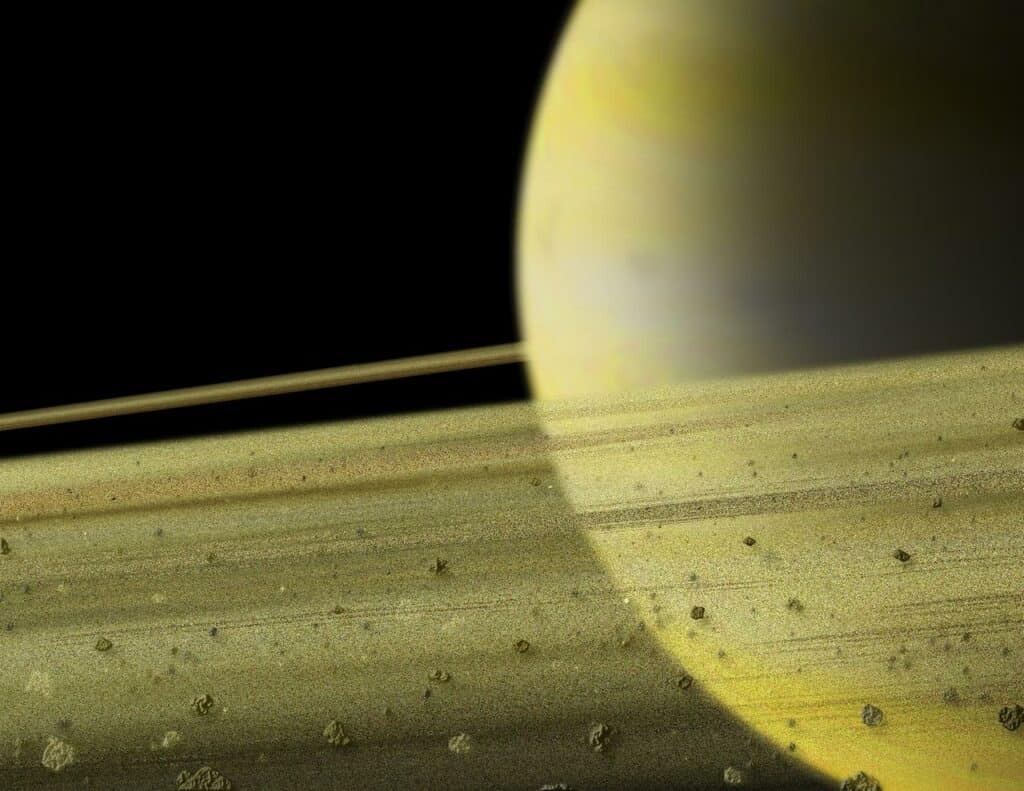
However, the rings are just the beginning. Saturn, also has a unique composition, magnetic fields, and more than 80 known moons, some of which hold great potential for further research and potential future space missions.
Saturn’s Physical Characteristics
Saturn, the sixth planet from the Sun, is a gas giant with an impressive ring system that makes it one of the most visually stunning celestial objects in our solar system.
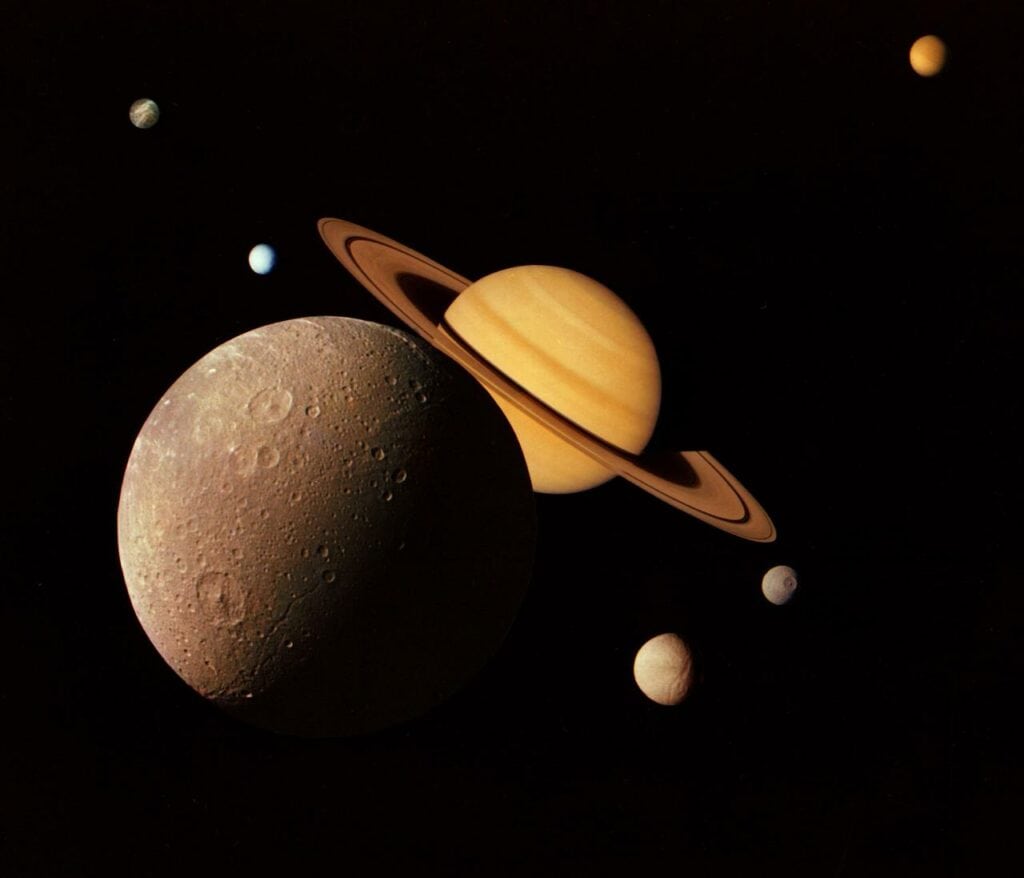
The planet’s diameter measures approximately 72,367 miles (116,460 kilometers) across, making it about 9 times wider than Earth. Its mass sits at 95 times that of Earth, which makes it much lighter than Jupiter, the largest planet in our solar system.
The composition of Saturn is mainly hydrogen and helium.
It is believed that the planet may have a small core, but that has yet to be definitively confirmed.
The layer surrounding this core is likely composed primarily of metallic hydrogen, which has unique properties due to the extreme pressure and temperature conditions inside the planet.
Here are some key facts about Saturn’s size and composition:
- Diameter: 72,367 miles (116,460 kilometers)
- Mass: 95 times Earth’s mass
- Composition: Predominantly hydrogen and helium
The incredible beauty of Saturn’s rings is due to their structure and composition.
These rings are composed of countless particles that range in size from small dust grains to large chunks of ice and rock.
These particles orbit the planet at varying distances, which results in the visible bands and gaps that characterize the ring system.
Saturn’s Atmosphere
Composition and Weather Patterns
Saturn’s atmosphere is primarily composed of hydrogen and helium, with trace amounts of ammonia, methane, and water vapor.
This gas giant also exhibits complex weather patterns that are driven by rapid rotation and temperature differences.
Vertical Structure of the Atmosphere
The atmosphere of Saturn can be divided into several layers:
- Troposphere: The lowest layer, where weather takes place, and temperature decreases with height.
- Stratosphere: The layer above the troposphere, where temperatures either remain constant or slightly increase with altitude.
- Thermosphere: The uppermost layer where extreme heating takes place due to solar radiation.
Saturn’s upper atmosphere, where planet meets space, plays a crucial role in understanding space weather and its impact on planets in our solar system and exoplanets.
Weather Patterns on Saturn
Saturn’s weather patterns are known for their high-speed winds that can reach up to 1,100 miles per hour in the planet’s equatorial region.
These winds are mainly caused by the rapid rotation of the planet – around once every 10.7 hours – leading to a flattened shape.
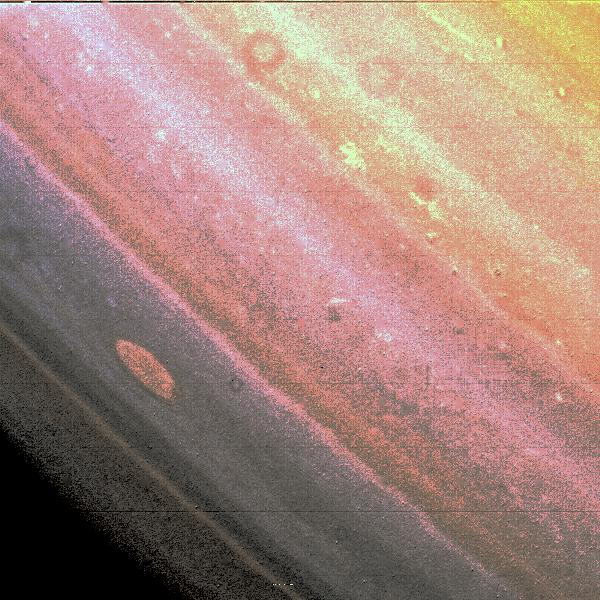
Storms on Saturn are common, and the most famous one is the Great White Spot, a massive storm that occurs roughly once every Saturnian year (about 29.5 Earth years).
Finally, Saturn’s atmosphere is also known for its hexagon-shaped jet stream at the north pole.
This curious structure, first discovered by Voyager 1, still puzzles scientists.
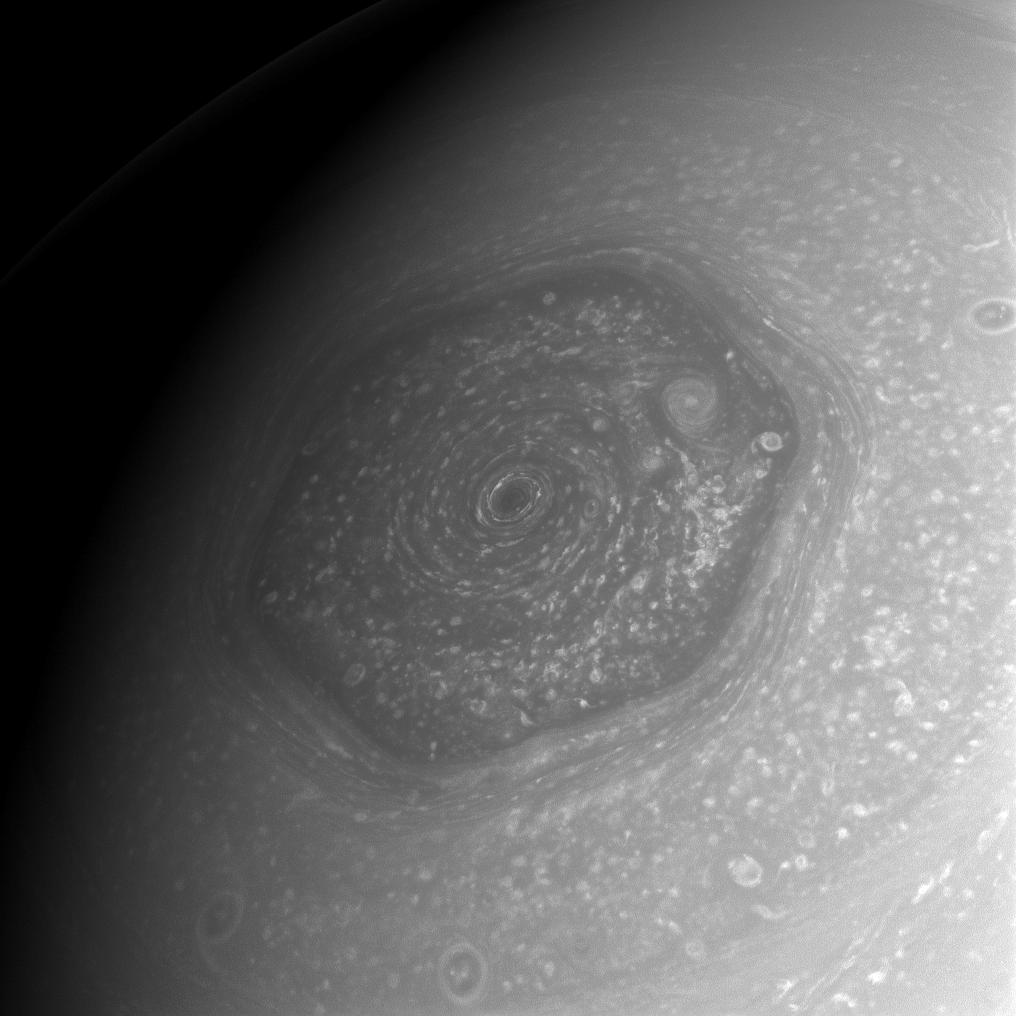
Recent data from NASA’s Cassini mission has shed some light on this phenomenon, but much remains to be understood about its origin and dynamics.
In terms of temperature, the upper atmosphere of Saturn is surprisingly warm considering its distance from the Sun.
This has been a long-standing atmospheric mystery that the data collected by Cassini is helping to unravel, providing a better understanding of the heating mechanisms at play.
Saturn’s Moons
When it comes to the wonders of our solar system, the planet Saturn and its fascinating system of moons never cease to captivate the curiosity of astronomers and enthusiasts alike.
As of November 2023, Saturn has a total of 145 known moons, with many more yet to be discovered.
Titan and Other Notable Saturn Moons
Among Saturn’s moons, Titan is the largest and most intriguing.
It is the second-largest moon in our solar system, only surpassed by Jupiter’s Ganymede.
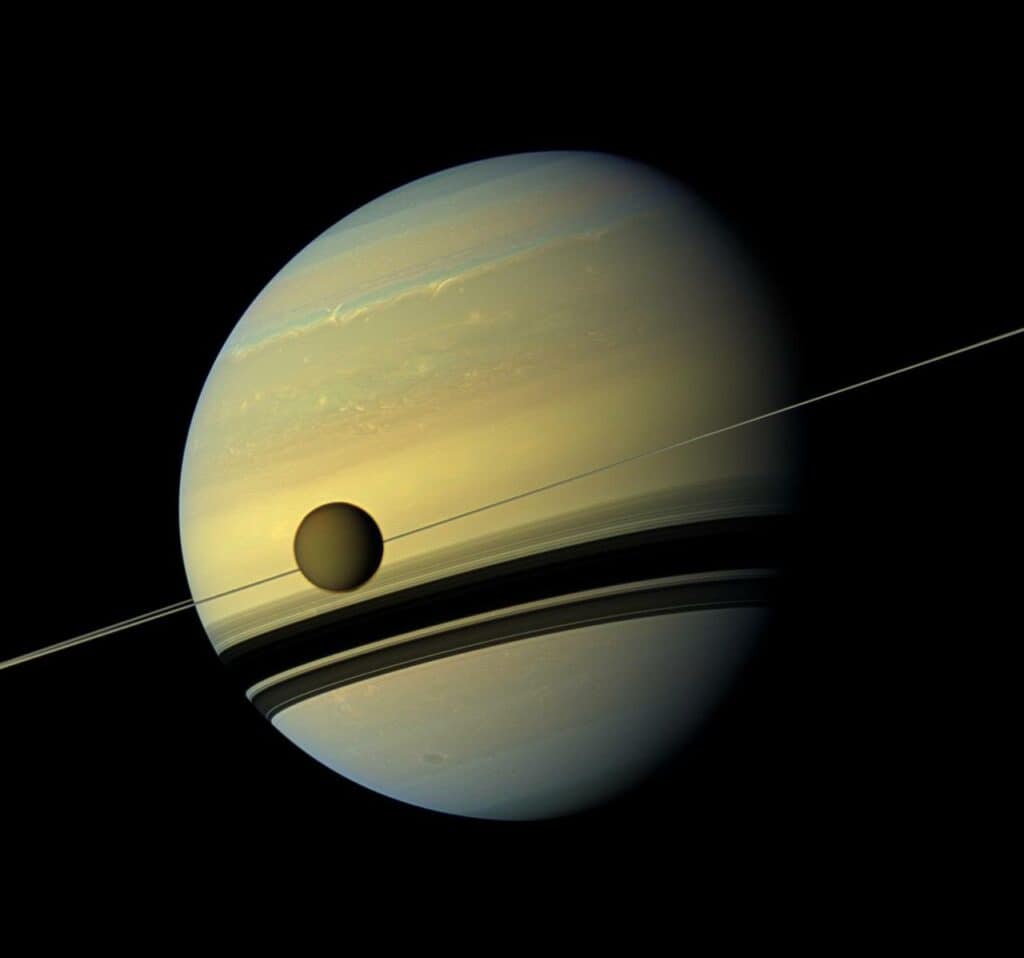
Titan is even larger than the planet Mercury and showcases a thick, nitrogen-rich atmosphere that is reminiscent of a primitive Earth.
The moon’s surface has liquid methane and ethane lakes, and its geological features include dunes, valleys, and mountains, making Titan a prime focus for future space missions.
Aside from Titan, Saturn has other remarkable moons worth mentioning:
- Enceladus: An icy moon with a plume of water vapor and organic materials, suggesting the possibility of subsurface liquid water that could potentially harbor life.
- Mimas: Often referred to as the “Death Star” moon due to its large impact crater, resembling the well-known Star Wars space station.
- Iapetus: A striking two-toned moon with a mysterious equatorial ridge.
- Rhea: Saturn’s second-largest moon, which is speculated to have a thin atmosphere, also known as an exosphere.
Exploration of Saturn
Past and Present Missions
Throughout history, various missions have explored the complex and captivating world of Saturn.
One of the most prominent and successful endeavors was the Cassini-Huygens mission, a collaboration between NASA and the European Space Agency (ESA). Launched in 1997, Cassini provided invaluable insights into Saturn’s atmosphere, storms, and temperature shifts.
The Huygens probe, the first human-made object to land on a distant world in the outer solar system, was carried to Saturn by the Cassini spacecraft.
In addition to Cassini, Saturn has been visited by other missions like Voyager 1 and Voyager 2.
Both spacecraft observed and studied Saturn’s unique features, providing us with a better understanding of the planet’s mesmerizing characteristics.
Here’s a quick timeline of these significant missions:
- 1980: Voyager 1 flyby
- 1981: Voyager 2 flyby
- 2004-2017: Cassini-Huygens mission
While the Cassini mission concluded in 2017, scientists continue to analyze data from the mission, uncovering more secrets about Saturn. Some fascinating discoveries made by these missions include:
- The unexpected complexity of Saturn’s rings, varying in size, color, and density.
- The discovery of new moons, such as the intriguing moon Enceladus, with geysers of water and signs of possible subsurface oceans.
- Detailed observations of the planet’s massive storms and jet streams.
Although Cassini came to its end after a planned plunge into Saturn’s atmosphere, the information gathered continues to provide a wealth of knowledge. Future missions and studies will undoubtedly further unravel the mysteries of this magnificent ringed giant.
Future Missions and Studies
What’s Next for Saturn Exploration?
As we continue to uncover the mysteries of Saturn, I believe it’s important to keep up with the exciting missions and studies aimed at expanding our knowledge of the ringed giant.
In recent years, the Cassini-Huygens mission provided remarkable insights about Saturn’s complex atmosphere, rings, and moons, fundamentally altering our understanding of the solar system.
With the conclusion of Cassini, there’s an eagerness to explore new possibilities. In fact, NASA has been considering four potential missions as part of its Discovery Program, which could deepen our understanding of the solar system and our place within it.
Some of the key areas for future exploration include:
-
Saturn’s atmospheric composition: Cassini revealed subtle, multi-hued atmospheric bands on Saturn, but the exact composition of the material responsible for these colors is still unknown. By studying the atmosphere more closely, we can determine the nature of these compounds and learn more about the planet’s unique weather patterns.
-
Saturn’s moons: The Cassini mission discovered numerous fascinating features on Saturn’s moons, including the potential for liquid water beneath the surface of Enceladus and Titan. Future missions could further examine these intriguing bodies and their potential for harboring life.
-
Rings dynamics: Saturn’s rings are still shrouded in mystery, with questions remaining about their age, structure, and interactions with the planet. Future missions could focus on studying the rings in even greater detail, revealing more about their formation and evolution.
Overall, the future of Saturn exploration is filled with promise, with numerous opportunities for groundbreaking discoveries waiting to be made. As a passionate observer of the solar system, I am excited to see what we uncover next about this beautiful and complex ringed giant.
Saturn’s Place in the Solar System
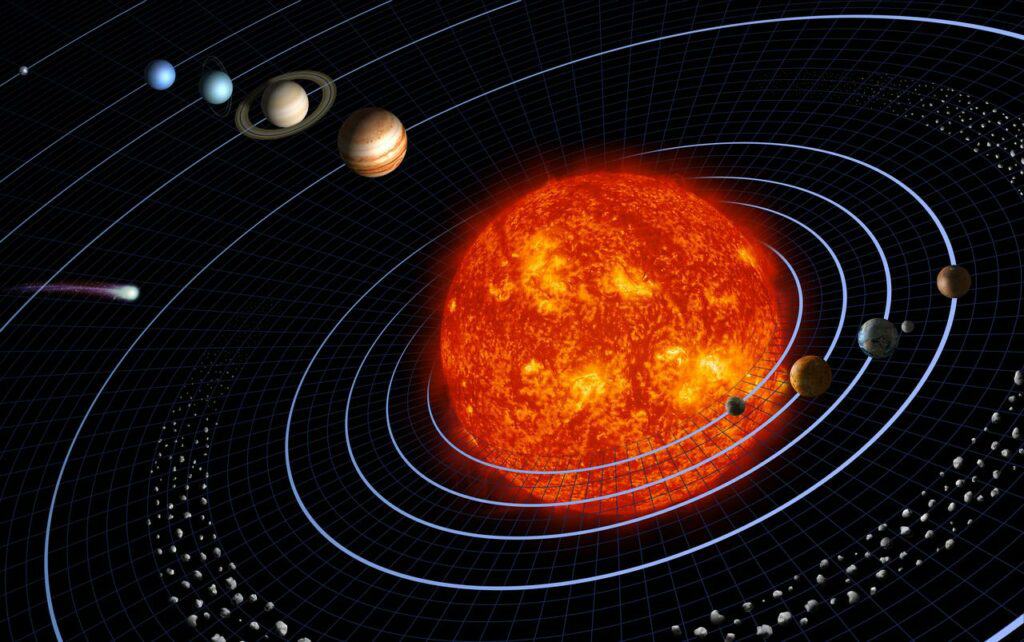
As a part of the solar system, Saturn stands out for its iconic rings and its size.
Saturn is the sixth planet from the Sun and is considered a gas giant, similar to Jupiter.
Among the gas giants, which also include Uranus and Neptune, Saturn shares many similarities such as being composed primarily of hydrogen and helium.
However, some differences set Saturn apart from the others.
One of Saturn’s main contrasts to other planets is its spectacular rings.
While all gas giants have ring systems, none are as extensive or as visible as Saturn’s rings.
The rings consist mainly of ice particles and some rock, and they are quite thin relative to their overall size.
I would also like to point out Saturn’s relative size and mass among the planets.
While it is the second-largest planet in the solar system, it has the lowest density.
In fact, its density is lower than water, meaning that if there were an ocean large enough, Saturn would actually float.
| Property | Saturn | Jupiter | Earth |
|---|---|---|---|
| Average Diameter | 116,460 km | 139,822 km | 12,742 km |
| Mass | 5.68 × 10²⁶ kg | 1.90 × 10²⁷ kg | 5.97 × 10²⁴ kg |
| Density | 0.69 g/cm³ | 1.33 g/cm³ | 5.51 g/cm³ |
In terms of its position in the solar system, Saturn has a unique role.
Its large mass and distance from the Sun create a stabilizing gravitational influence on nearby objects, such as asteroids and smaller celestial bodies.
This influence can help keep those objects in check and reduce the likelihood of collisions with other planets, including Earth.
Saturn’s atmosphere also sets it apart, consisting mainly of hydrogen and helium.
It has notable features like the hexagonal storm at its north pole, which has not been observed on any other planet in the solar system.
This huge storm system, with each side measuring more than the diameter of Earth, has been puzzling scientists since its discovery.
To summarize, Saturn is a fascinating and unique planet, and its comparisons and contrasts to other planets in the solar system make it a truly interesting topic of study. Its iconic rings, size, density, atmosphere, and position are just a few of the aspects that set it apart.


